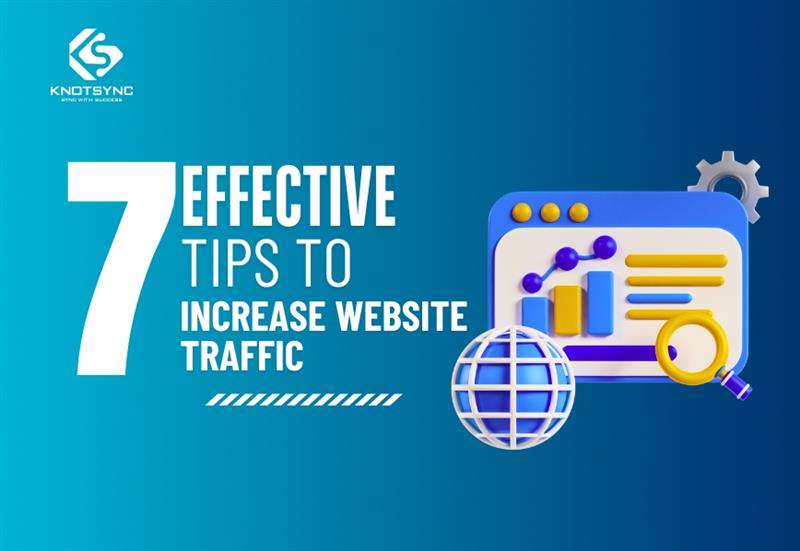Imagine spending hours creating blog posts, updating your website, and posting on social media, but when you check your analytics, and see barely any traffic.
You know your content is good, but somehow, it’s barely seen. Yes, it’s really frustrating and leaves you wondering if all your efforts are going to waste.
But the truth is, having a website or content alone isn’t enough. Without a proper strategy to attract visitors, your hard work stays hidden, your leads dry up, and your business misses out on potential opportunities.
Most marketers struggle with the same challenge: “How to increase the traffic of a website?”
Well, the good news is that you can drive traffic without blowing a massive budget. By following these seven effective tips given in this blog, you can attract more visitors, increase engagement, and turn curious clicks into loyal customers.
Without any further ado, let’s dive straight into these tips.
Top 7 Effective Tips to Increase Website Traffic in 2025
Getting more visitors to your website is all about using smart, practical strategies that actually work. The right approach can help you attract the people who are interested in your content, keep them engaged, and turn visits into meaningful interactions. Let’s look at the tips to increase website traffic in detail:
1. Build Both Internal Links and Backlinks
Link building is an important exercise that can help drive more traffic to your site. It’s when you gain hyperlinks that will lead back to your website. So, focus on building both internal links and backlinks.
When you add internal links in your blog post, you redirect the users to your own pages on your site. This tactic not only keeps users engaged on your page longer but also results in a better user experience – the cornerstone of increasing traffic to your website.
The more time users spend on your page, the better. It will tell Google that your site is interesting and engaging for your audience. Google will then rank your site higher on its SERPs (Search Engine Result Pages), driving more quality traffic to your website. As a result, you will get more valuable leads for your business.
Here are a few tips for internal linking:
- Link to related blog posts or cornerstone pages naturally within your content.
- Use descriptive anchor text that tells so both users and Google can understand what the linked page is about.
- Don’t overdo it – focus on quality, not quantity.
In addition to internal links, backlinks (a link to your website from a high authority website) play a significant role in driving more Google traffic to your website. Earning backlinks from credible sites in your industry means that you are credible and trustworthy.
When these credible sites provide a link to your content on their site, traffic to your page will increase. The best way you can earn a backlink is by:
- Create Quality Content: Write content that others want to reference, think guides, case studies, or in-depth tutorials.
- Guest Posting: Offer to write for reputable sites in your industry and include a link back to your relevant page.
- Outreach & Relationship Building: Reach out to bloggers, journalists, or companies who might find your content valuable. Personalized emails go a long way.
- Leverage Existing Mentions: If someone mentions your brand but doesn’t link to you, politely ask for a backlink.
Make sure to focus on relevance over volume. A single backlink from an authoritative site in your niche is far more valuable than dozens from unrelated sources.
2. Create and Publish Quality Content
Do you know that around 77% of internet users still read blogs? So, if your website isn’t publishing content that people actually want to read, you’re missing out on a massive opportunity.
Creating relevant and useful content can have a positive impact on your website. It helps drive more traffic to your website. When you create content, you provide internet users with valuable information they are seeking and answer the questions they ask Google.
But before you write any content, you must ask yourself:
- Who am I writing for?
- What problems are they trying to solve?
- What questions do they ask online?
If you responded to their questions well, they would turn to you in the future as well, boosting your website traffic and on-site engagement. Furthermore, when the time to convert comes, they may choose your business over the competition because they trust that you know your field.
While creating content, don’t forget to add keywords relevant to your industry. This will help you create industry-specific content that will drive targeted leads that are interested in your business. Here’s how you can do your keyword research using keyword research tools.
- Use tools like Google Keyword Planner, SEMrush or Ubersuggest to find relevant keywords.
- Focus on long-tail keywords that match what people are actually searching for. For example, instead of “running shoes,” target “best running shoes for beginners.”
- Include keywords naturally in your headings, meta descriptions, and throughout your content.
For example, if you are the owner of an eCommerce website that sells footwear, you can perform keyword research using SEMrush. Use the keywords that you get after your research in the content that you create.
You can also create numerous forms of content, like:
| Content Type | Best For | Example Topic | Why It Works |
| Blog Post | SEO + authority | “10 Tips to Prevent Running Injuries” | Easy to optimize, shareable, builds trust |
| Infographic | Shareability | “Running Shoe Trends 2025” | Visual and quick to consume, highly shareable |
| eBook | Lead generation | “Beginner’s Guide to Running Shoes” | Offers in-depth info in exchange for emails |
| Video | Engagement + conversions | “How to Choose the Right Running Shoes” | Increases time on page, SEO, and trust |
| Newsletter | Retention | Weekly tips & new product updates | Keeps audience coming back to your site |
A well-researched and detailed post that genuinely helps readers is far more valuable than multiple shallow posts.
You will need to see what your audience likes to create content that they want to see. They can even help you earn backlinks from authority sites. So, start with writing quality blogs.
3. Incorporate Videos
With the rise of YouTube, videos are gaining more traction over any other form of content. Videos can attract new visitors to your site and make it more engaging. As a result, driving more traffic to your website and improving its ranking.
The impact videos can have on your website is astounding. Do you know that having videos on a website can increase website traffic by 157%?
There are many different types of videos that you can make, like:
| Video Type | Best For | Example Topic |
| How-To / Tutorial | Solve problems | “How to Choose the Perfect Running Shoes” |
| Product Demo / Review | Show value | “Try On: Top 5 Running Shoes of 2025” |
| Customer Testimonials | Build trust | “Why Runners Love Our Shoes” |
| Interviews / Expert Talks | Authority & engagement | “Coach’s Tips for Beginner Runners” |
| Live Videos | Real-time engagement | Q&A session about running shoe care |
Practical Tips to Maximize Video Impact
Unlike text alone, videos capture attention, keep visitors on your site longer, and make your content more shareable. Simply adding the right type of video can turn casual readers into engaged visitors and even potential customers.
- Host Wisely: Upload to YouTube for discoverability, but also embed on your website to boost engagement and SEO.
- Optimize for Search: Use descriptive titles, keyword-rich descriptions, and tags. Add transcripts for accessibility and SEO benefits.
- Keep it Short and Engaging: Aim for 2–5 minutes for tutorials or product demos. Make sure to hook the viewers in the first 10–15 seconds.
- Include Calls-to-Action: Encourage viewers to visit your website, read a blog, or explore products.
Videos don’t have to be professionally shot to be effective. Clear audio, good lighting, and helpful content are far more important than cinematic perfection. So, what are you waiting for? Incorporate videos on your site today and get your audience engaged on your page.
4. Optimize Your Site for Mobile
In 2025, mobile devices accounted for 62.54% of global website traffic. If your website is not mobile friendly then the visitors will leave before exploring your content, and Google will notice. A poor mobile experience can harm both traffic and rankings.
Therefore, optimizing for mobile offers a better user experience and keeps users engaged. When they spend more time on your page, it boosts your ranking and helps you drive more Google traffic to your website.
Here are some signs that your website needs mobile optimization:
- Pages take too long to load on phones.
- The text is too small to read without zooming.
- Buttons and links are hard to click.
- Users have to scroll horizontally to see content.
Here are some practical ways to make your website better for mobile devices:
- Responsive Design: Make sure your website adjusts automatically to different screen sizes. Most modern themes and templates support this.
- Compress Images: Large images slow down mobile loading times. Use tools like TinyPNG or ImageOptim.
- Simplify Navigation: Use a clean menu and avoid clutter. Prioritize important pages and links.
- Avoid Pop-Ups on Mobile: Intrusive pop-ups frustrate users and can hurt rankings. If you must use them, make them mobile-friendly.
- Test Your Site: Use Google’s Mobile-Friendly Test to identify issues and fix them.
Mobile optimization isn’t a one-time task. Test your site regularly on different devices and screen sizes and update as needed.
5. Pay Attention to On-Page SEO
Optimizing content on your website for search engines like Google and Bing is a worthwhile practice. It helps search engines analyze your website and its content. On-page SEO helps Google understand what your page is about so it can show it to the right people. It could get you more visitors, giving a boost to organic traffic coming to your site.
Let’s break down the elements of on-page SEO that you need to optimize:
| Element | Why It Matters | How to Optimize |
| Meta Title | First thing users see on Google | Keep it under 60 characters, include your main keyword naturally |
| Meta Description | Encourages clicks | Keep it under 160 characters, use an action phrase (“Learn how to…”), include your keyword |
| Headings (H1, H2, H3) | Structure for readers & search engines | Use one H1 per page; include keywords in subheadings |
| URL Structure | Helps Google categorize your page | Keep URLs short, descriptive, and keyword-rich e.g., /Increase website traffic. |
| Content | Main reason users visit your page | Write for humans first, sprinkle keywords naturally, use short paragraphs and bullet points |
| Images | Visual appeal + SEO boost | Compress images, name files descriptively, add alt text with relevant keywords |
Here’s how you can do on-page SEO for your website:
- Start With the User’s Intent: Ask, “What would someone searching for this topic really want to find?” Then tailor your content to answer that question clearly and completely.
- Use Keywords Naturally: Avoid keyword stuffing. Instead, include variations and related terms naturally throughout your text.
- Add Internal Links: Link to relevant pages or blogs to keep readers exploring your site (and help search engines crawl it better).
- Optimize for Readability: Break text into short paragraphs, use headings, bullet points, and visuals. This makes your content easy to read.
- Refresh Old Content: Update outdated stats, fix broken links, and re-optimize for newer keywords every few months.
Tools like Yoast SEO or Rank Math (for WordPress) can help you audit your pages and ensure every on-page element is optimized for both search engines and readers.
6. Keep an Eye on Guest Posting Opportunities
Guest posting is a marketing practice where you write blog posts for other reputable companies or publications. In return, they usually allow you to link back to your site. Users who are unaware of your business are more likely to visit your site as your blog has been published on a high-authority site.
Getting your post published on a reputable site can help you get traffic to your website fast. You can look out for guest posting opportunities in the following ways:
- Identify Relevant Sites in Your Niche: Look for blogs or publications that share your target audience and have good authority.
- Check Authority and Audience: Focus on sites that have an active readership and engage with their content (comments, shares, social presence).
- Check Guest Posting Guidelines: Some sites accept guest posts openly, while others may require you to reach out via email.
- Pitch a Valuable Idea: Propose content that helps their audience. Avoid pitching self-promotional topics.
- Include a Relevant Backlink: Naturally link to a relevant page on your website. Don’t force it; make it helpful and contextual.
- Promote Your Guest Post: Share your guest post on social media, in your newsletter, and with your audience to maximize reach.
Additional tips to get backlinks to your website:
- HARO (Help a Reporter Out): Respond to journalist queries for mentions or backlinks.
- Broken Link Building: Identify broken links on relevant websites and offer your content as a helpful replacement.
- Mentions Without Links: If someone mentions your brand but doesn’t link, politely request a backlink.
Focus on quality over quantity. A single guest post on a high-authority, relevant site is more valuable than multiple posts on unrelated or low-quality sites. This way, you can get more traffic, backlinks, and visibility, leading to more visitors to your website.
7. Promote Your Content in Relevant Online Communities
Online communities are the best place to promote your content. Why? Because they are the places where you can find people with shared interests.
If you are a valued member of your relevant online community, have built strong relationships with its members, and participate actively in the group, you may get permission to promote your content. Here’s how to promote your site without spamming:
- Choose Relevant Communities: Facebook groups, Reddit, Slack communities, Medium publications, Growth Hackers; pick platforms where your ideal audience is active.
- Build Trust First: Join discussions, answer questions, and share helpful advice before posting your own content. People are more likely to engage with someone who adds value.
- Share Smartly: Post content that genuinely helps the community. For example, if a Reddit thread asks, “How do I choose the best running shoes?” you can share your detailed guide as a helpful resource.
- Engage With Responses: Respond to comments, thank people for feedback, and join follow-up discussions. This interaction increases visibility and encourages clicks.
- Track Results: Use UTM links or URL shorteners to monitor which communities drive the most traffic. Focus your efforts on the platforms that perform best.
Remember to share only relevant and high-quality content and not to spam groups with your content. It may backfire.
Takeaway
Next time you publish content on your website, make sure that you have followed the above-mentioned seven effective tips to drive traffic to your website. These tips are easy to follow and can be applied to both small businesses and big enterprises. They will increase website traffic, increase engagement, and convert users into customers.
And if you want to get in touch with a digital marketing expert to increase your online traffic, contact us today.




